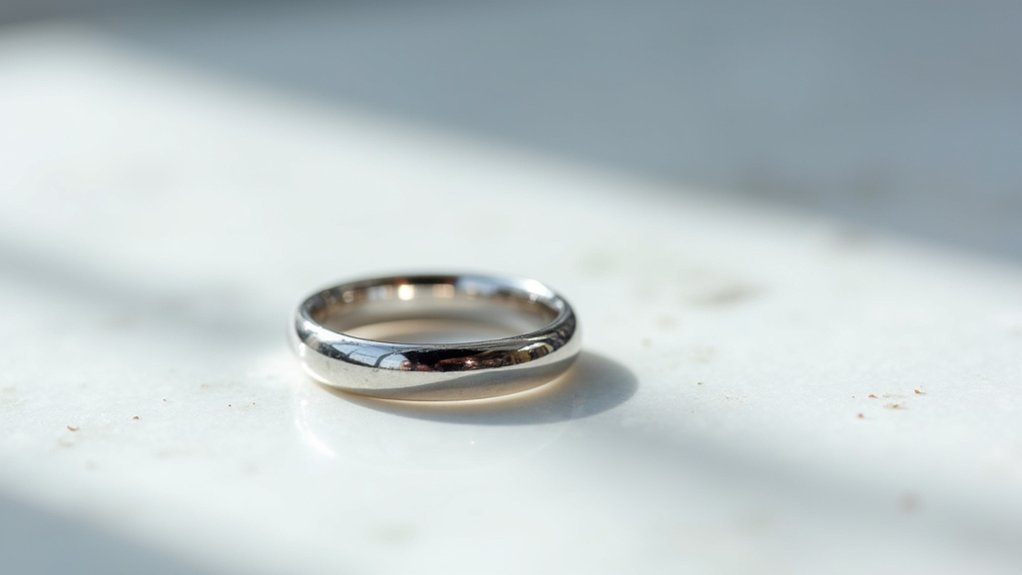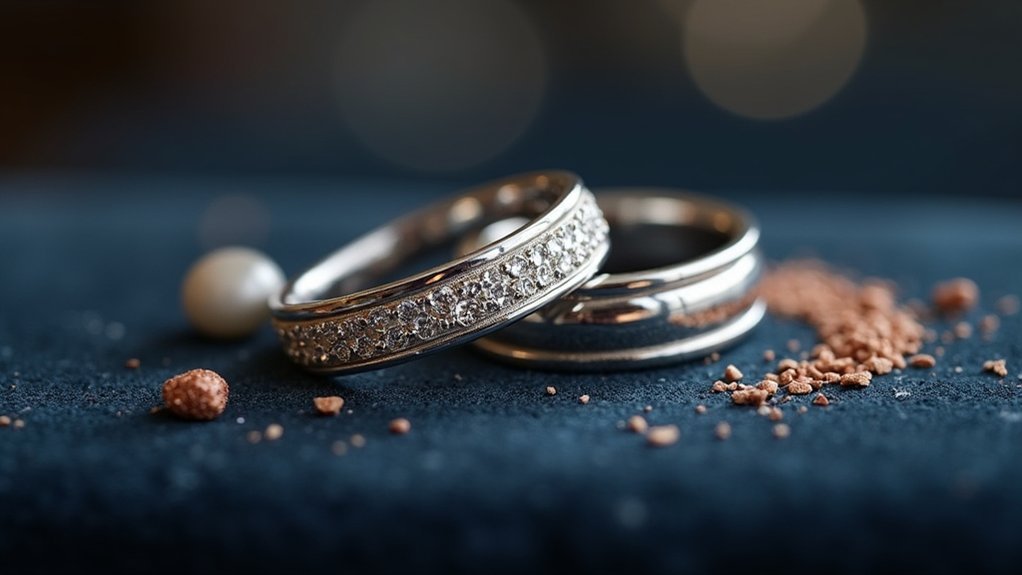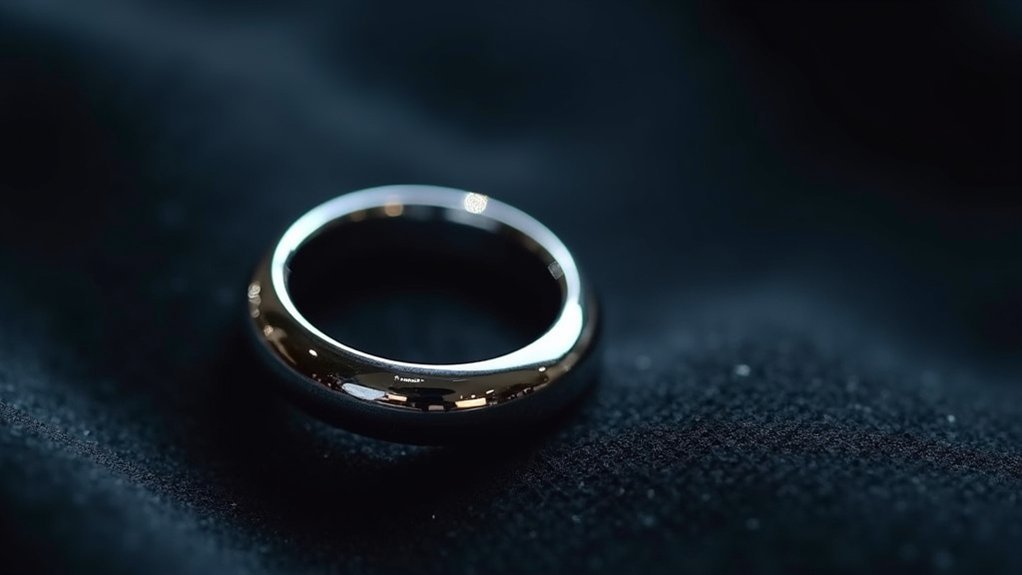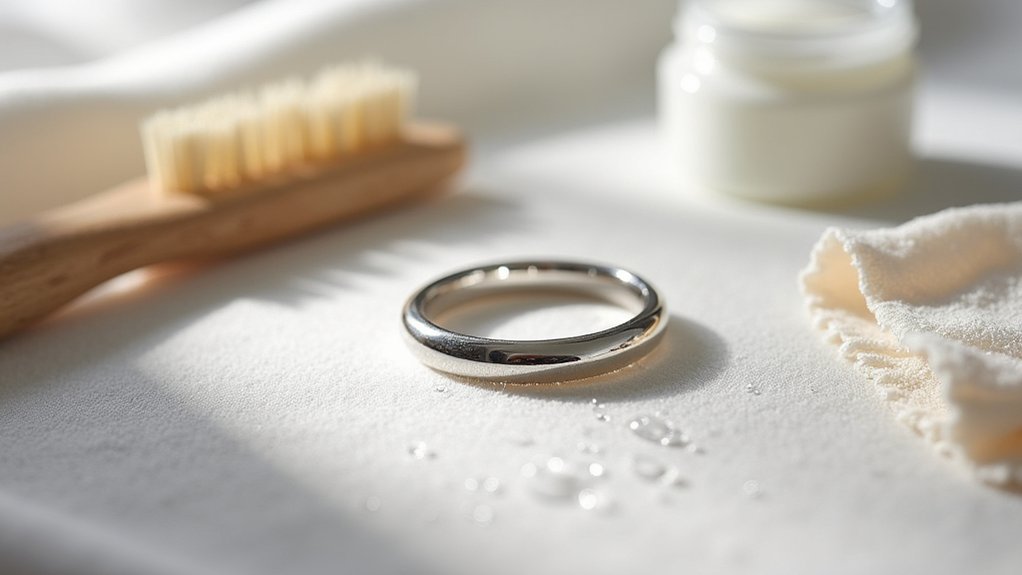Palladium’s 95% pure metal composition makes it truly hypoallergenic by naturally excluding nickel and cobalt, the primary allergens that cause contact dermatitis in jewelry wearers. You’ll benefit from its stable atomic structure that won’t break down or release irritating particles, while its inert properties prevent chemical reactions with your skin. Unlike other metals that require alloy mixtures or protective coatings, palladium’s solid construction maintains its hypoallergenic benefits throughout its lifetime, offering superior protection for sensitive skin without compromising durability or style.
Understanding Palladium’s Pure Metal Composition

Purity sets palladium apart from other jewelry metals, making it an exceptional choice for those with sensitive skin. When you choose palladium jewelry, you’re selecting a pure metal that’s naturally hypoallergenic without requiring additional processing or coatings.
Unlike other precious metals that need alloys mixed in for strength, palladium maintains its durability while staying nearly pure.
This pure metal composition means you won’t encounter common allergens like nickel that trigger skin allergies and irritation.
You’ll find that palladium’s atomic structure creates a naturally stable metal that doesn’t break down or release particles that cause reactions.
Since it doesn’t require rhodium plating or other surface treatments, there’s no risk of underlying alloys causing problems when coatings wear off over time.
The Science Behind Palladium’s Hypoallergenic Properties
You’ll find that palladium’s hypoallergenic nature stems from its remarkably pure metal structure, which contains 95% pure palladium with minimal alloying elements.
Unlike many jewelry metals, palladium doesn’t require nickel in its alloy composition, eliminating the primary culprit behind most metal allergies.
This nickel-free formula means you won’t experience the redness, itching, or irritation that typically occurs with traditional jewelry metals.
Palladium’s Pure Metal Structure
Understanding the molecular makeup of palladium reveals why it’s become a premier choice for sensitive skin. This noble metal maintains extraordinary purity levels typically exceeding 95%, which means you’re getting pure metal without troublesome allergens like nickel that trigger skin reactions in traditional jewelry alloys.
Palladium’s atomic structure provides remarkable durability and malleability without requiring additional metals that compromise its hypoallergenic qualities. You won’t find the irritating compounds that plague other jewelry materials.
Its resistance to tarnishing and corrosion guarantees your pieces maintain their lustrous appearance while remaining gentle against your skin over time.
Unlike other metals requiring rhodium plating, palladium jewelry puts you in direct contact with pure, hypoallergenic material. This noble metal’s inert properties mean it won’t react chemically with your skin, eliminating common allergic responses.
Nickel-Free Alloy Composition
When selecting hypoallergenic jewelry, palladium’s nickel-free composition eliminates the primary culprit behind metal allergies that affect millions of people worldwide.
Unlike many precious metals that require nickel alloys for strength, palladium’s natural malleability allows jewelers to create durable pieces without adding irritating elements.
You’ll find that this nickel-free characteristic sets palladium apart from white gold and other metals that often trigger allergic reactions upon skin contact.
The absence of nickel means you won’t experience the redness, itching, or swelling commonly associated with metal sensitivities.
Since palladium maintains its structural integrity without nickel reinforcement, you’re getting jewelry that’s both beautiful and safe.
This pure composition guarantees your hypoallergenic jewelry remains gentle against your skin throughout extended wear.
Common Jewelry Allergens That Palladium Avoids

When you’re shopping for jewelry, you’ll want to avoid common allergens like nickel and cobalt that trigger reactions in millions of people worldwide.
Nickel, found in many jewelry alloys, causes contact dermatitis and skin irritation, while cobalt can produce similar allergic responses.
Palladium’s pure composition naturally excludes these problematic metals, giving you a safer alternative that won’t compromise your skin’s health.
Nickel-Free Metal Properties
Since nickel ranks as the most prevalent jewelry allergen affecting millions of people worldwide, palladium’s completely nickel-free composition makes it an exceptional choice for sensitive skin. Unlike white gold alloys that rely on nickel for their color, palladium naturally maintains its silvery-white appearance without requiring allergenic additives.
This precious metal’s inherent purity gives you confidence in wearing jewelry without triggering allergic reactions. You’ll benefit from palladium’s 90% or higher purity levels, which eliminate the risk factors present in other metals.
| Metal Type | Nickel Content |
|---|---|
| White Gold | Often contains nickel |
| Sterling Silver | May include nickel alloys |
| Palladium | Completely nickel-free |
| Platinum | Naturally nickel-free |
Palladium’s hypoallergenic properties make it ideal for those with nickel allergies.
Cobalt Avoidance Benefits
While nickel remains the primary concern for jewelry allergies, cobalt presents another significant threat that palladium completely eliminates.
You’ll find cobalt lurking in many platinum alloys, where it’s added to increase durability and reduce costs. This metal can trigger severe allergic reactions, causing redness, swelling, and persistent skin irritation that’s often mistaken for nickel sensitivity.
When you choose palladium jewelry, you’re selecting a hypoallergenic metal that’s naturally cobalt-free.
Unlike those problematic platinum blends, palladium maintains its strength and beauty without requiring cobalt additives. This means you can wear your jewelry confidently, knowing you won’t develop contact dermatitis or other allergic responses.
For those with known cobalt sensitivities or multiple metal allergies, palladium offers the peace of mind you deserve.
How Palladium Compares to Other Hypoallergenic Metals
Although many metals claim hypoallergenic properties, palladium stands out as one of the purest options available for sensitive skin. When you’re comparing hypoallergenic metals, you’ll find palladium doesn’t require nickel or irritating additives in its composition, unlike many jewelry alloys.
While sterling silver often contains trace nickel amounts that can trigger a nickel allergy, palladium remains consistently pure, eliminating this concern entirely.
You’ll discover palladium offers platinum’s durability without the hefty price tag, making it more accessible than traditional hypoallergenic metals. Its lightweight nature and malleability allow intricate designs while preventing skin irritation.
For those experiencing allergic reactions to common metals, palladium provides reliable protection without compromising style or comfort in your jewelry choices.
Palladium’s Natural Resistance to Tarnishing and Corrosion

Palladium’s exceptional resistance to tarnishing and corrosion stems from its remarkably stable chemical structure, ensuring your jewelry maintains its lustrous appearance for years without constant maintenance. Unlike other metals that oxidize and lose their shine, palladium doesn’t require frequent polishing to stay brilliant.
| Property | Palladium Performance | Benefit |
|---|---|---|
| Tarnishing | Never tarnishes | Permanent shine |
| Corrosion | Highly resistant | Long-lasting durability |
| Reactivity | Minimal chemical reactions | Reduced skin irritation |
This durable metal withstands daily wear while maintaining its hypoallergenic properties. Since palladium doesn’t react with moisture or chemicals, you’re less likely to experience allergic reactions or skin irritation. Its natural resistance eliminates the risk of metal particles breaking down against your skin, making it ideal for sensitive individuals.
Why Palladium Doesn’t Require Rhodium Plating
Unlike white gold that requires rhodium plating to mask its yellowish tint and prevent nickel allergies, palladium’s naturally pure composition eliminates this necessity entirely.
You’ll find that palladium maintains its brilliant silvery-white appearance without any additional coatings, making it inherently hypoallergenic for sensitive skin.
When you choose palladium jewelry, you’re avoiding the potential allergic reactions that can occur when rhodium plating wears off other metals.
This durability advantage means your palladium pieces won’t develop exposed areas that could trigger skin sensitivities.
The manufacturing process becomes simpler too, as jewelers don’t need the extra plating steps required for other metals.
You’ll appreciate that palladium’s natural resistance to tarnishing and corrosion keeps your jewelry looking pristine without protective layers.
Identifying Allergic Reactions to Non-Hypoallergenic Jewelry

When your skin develops redness, swelling, or itching within 12 to 24 hours of wearing jewelry, you’re likely experiencing an allergic reaction to non-hypoallergenic metals.
Blistering can also occur, making these symptoms unmistakable signs of contact dermatitis.
Nickel content is the primary culprit, affecting about 20% of people. You might think you’re allergic to gold or silver, but nickel alloys in these jewelry pieces are usually responsible.
Nickel allergies affect one in five people, often hiding in gold and silver jewelry through metal alloys.
Continued exposure worsens symptoms, potentially causing chronic dermatitis.
Your symptoms should disappear within days after removing the problematic jewelry.
However, don’t guess which metal triggers your reactions. Schedule a patch test with a dermatologist to identify specific metal allergies accurately.
This testing helps you choose the right hypoallergenic option for future jewelry purchases.
Choosing Quality Palladium for Sensitive Skin
Since palladium contains minimal alloying elements, it’s naturally suited for people with sensitive skin who’ve experienced reactions to other jewelry metals. When selecting palladium pieces, you’ll want to verify the purity level to guarantee maximum hypoallergenic benefits.
| Quality Factor | Why It Matters | What to Look For |
|---|---|---|
| Purity Level | Higher purity means fewer irritants | 95% palladium content or higher |
| Nickel-Free | Eliminates common allergen triggers | Certified nickel-free composition |
| No Plating | Prevents reactions from coating materials | Solid palladium construction |
Quality palladium jewelry eliminates the need for rhodium plating, which can trigger metal allergies. Its malleability allows jewelers to craft designs without additional metals that might cause reactions. You’ll find durable palladium pieces resist tarnishing while providing comfortable, long-lasting wear for sensitive skin.
Caring for Palladium Jewelry to Maintain Hypoallergenic Benefits

Proper care of your palladium jewelry guarantees its hypoallergenic properties remain intact throughout years of wear.
Regular cleaning with a soft cloth removes accumulated dirt and oils that could trigger skin irritation. When storing your pieces, choose dry, cool locations with fabric-lined boxes to prevent tarnishing and scratching that compromises hypoallergenic benefits.
Avoid exposing your jewelry to harsh chemicals, perfumes, or lotions that can degrade the metal’s surface and cause reactions.
Inspect pieces periodically for damage or rough edges that might irritate sensitive skin, seeking professional polishing when necessary.
Ensure proper fitting when wearing palladium jewelry, as poorly fitted pieces create friction and discomfort.
Following these caring for palladium jewelry practices preserves its natural hypoallergenic properties and keeps your skin comfortable.
Frequently Asked Questions
Is Palladium Jewelry Hypoallergenic?
Yes, you’ll find palladium jewelry highly hypoallergenic because it’s naturally pure and doesn’t contain nickel or other common allergens. You won’t experience irritation, making it perfect if you’ve got sensitive skin or metal allergies.
What Metal Is 100% Hypoallergenic?
You’ll find that palladium is considered 100% hypoallergenic because it’s naturally pure and doesn’t contain nickel or other common allergens that typically cause skin reactions in sensitive individuals.
Can People Be Allergic to Palladium?
You can be allergic to palladium, but it’s extremely rare. Most people with metal sensitivities don’t react to palladium since it’s naturally pure and doesn’t contain common allergens like nickel.
Is Palladium Good for Sensitive Skin?
You’ll find palladium excellent for sensitive skin since it’s naturally hypoallergenic with 95%+ purity. It doesn’t contain nickel, won’t cause reactions or discoloration, and you can wear it comfortably every day.
In Summary
You’ll find palladium jewelry offers unmatched hypoallergenic properties thanks to its pure composition and natural resistance to tarnishing. You won’t need to worry about common allergens like nickel or the irritation caused by rhodium plating wearing off. When you choose quality palladium pieces and maintain them properly, you’re investing in jewelry that’ll remain gentle on your sensitive skin for years to come without compromising style or durability.





Leave a Reply